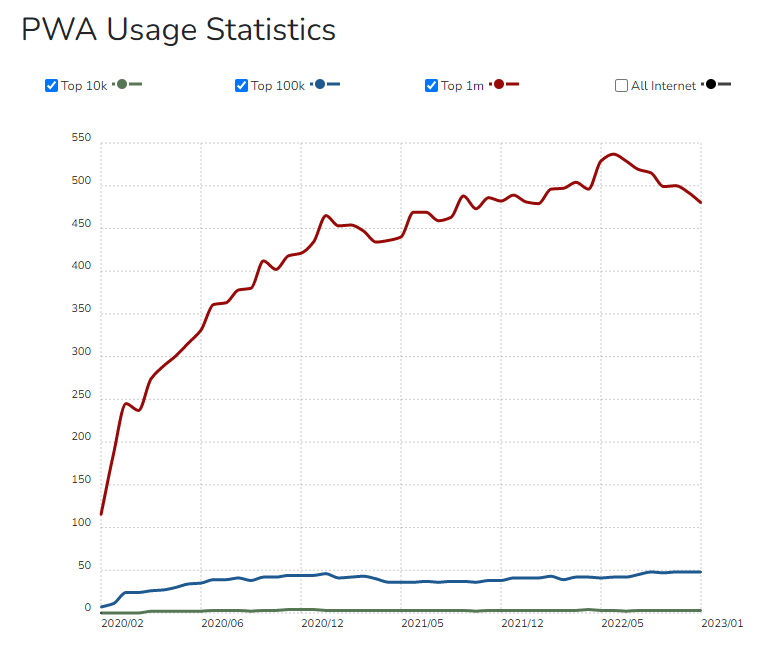Is PWA still relevant?
Auteur(s) de l'article
A PWA (progressive web app) is a fusion between a website and a native mobile application. It's a bit like having a website with all the features and functions of a mobile application, without the need for installation.
You can install them on your home screen directly from your browser, without going through a store. They're fast, offer caching, PUSH notifications and even offline pages if your Internet connection ever goes on the fritz.
Forbidden fruit 🍎
While PWAs are fairly well established on Chromium browsers (which overwhelmingly dominate the browser market), the same cannot be said for Safari, the browser from Apple.
On Chromium browsers, if the website is properly configured to support PWAs, it is possible to provide a simple and intuitive installation experience thanks to the
beforeInstallPrompt.Unfortunately, this isn't the case with Safari, which doesn't provide any simple means of installing a web application. So you have to go through all the steps yourself, which slows down the adoption of web apps on iOS.

A glimmer of hope 🌥️
Little known to consumers in the Apple ecosystem (and rightly so), their adoption has stagnated for over 10 years despite the benefits they can bring… But wait, what am I seeing here?
With the release of iOS 16.4, push notifications have finally become an integral part of PWAs on iOS.
So it's now possible, for example, to install the WhatsApp web app on your iPad and receive notifications (there is no native version of WhatsApp on iPad).
This step forward on Apple's part gives us hope that one day we might see a simplified installation process like on Android.
What does the future hold for PWAs?
Despite a stable or even declining adoption rate, PWAs are a good way of launching a product quickly and at a lower cost. They offer an experience close to that of native applications.

PWAs continue to be an attractive option for businesses wishing to provide a mobile experience without having to develop separate native applications for each platform.
They have demonstrated their ability to improve user engagement and reduce bounce rates, making them a viable solution for many use cases.
Les PWA continuent d'être une option intéressante pour les entreprises souhaitant fournir une expérience mobile sans avoir à développer des applications natives distinctes pour chaque plate-forme.
P TWA
Because using just one acronym would be too simple, here's TWA!
“ Trusted Web Activities ”
In a nutshell, it's an evolution of the PWA, designed to integrate secure Web content into a native Android application. By following Google's instructions, you can transform your PWA into a TWA and publish it on the PlayStore.
Unlike PWAs, TWAs offer deeper integration with the Android operating system, enabling users to interact through a native experience, as if it were a traditional application, while retaining the advantages of a web application. Updates made to your site will therefore be directly accessible from your PWA!
As well as enjoying all the benefits of PWAs, TWAs also offer integration with Android features such as Shared Action for sharing data with other applications, single sign-on and access to the system's native APIs.
It should be noted, however, that TWAs are specific to Android and are not available on other mobile platforms such as iOS.
In conclusion
Despite a rather slow adoption rate, PWAs offer an experience similar to that of native applications at a lower cost, and can even be published on the PlayStore thanks to Trusted Web Activities.
PWAs are ideal for :
- Immediate cross-platform availability
- Intense development phases where updates can be published without users having to update their application.
- Simple cases such as e-commerce sites, blogs, editorial sites and dashboards.
Whereas a native mobile application is more advantageous when more advanced functions are required, such as :
- Image processing
- Hardware-intensive tasks
- AR and video games